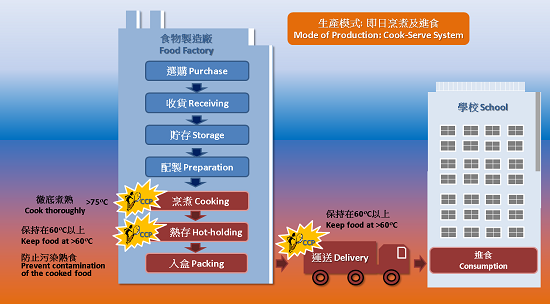
   |
Food Safety Focus (118th Issue, May 2016) – Food Safety Platform
Putting an Effective Food Safety System in Place –
HACCP for Food Businesses
Reported by Dr. Anna S.P. TANG, Scientific Officer,
Risk Communication Section,
Centre for Food Safety
Following from the last article on the background and principles of the HACCP (Hazard Analysis Critical Control Point) system, let's move on to see how this effective system may be implemented in food businesses to enhance and improve food safety.
Applying the HACCP System in Food Businesses
Prevention is better than cure: HACCP adopts a preventive and proactive approach to anticipate the occurrence of potential problems during the food production process and to implement measures designed to prevent the occurrence of these problems. The prime objective of implementing HACCP systems in food businesses is to provide efficient and cost-effective arrangements governing safe and hygienic production, storage, transportation and handling of food.
What are the Pre-requisites for Implementing HACCP?
An effective implementation of a prerequisite programme (PRP) can facilitate introduction of HACCP in food businesses. PRP may be in the form of Good Manufacturing Practices (GMP) and Sanitation Standard Operating Procedures (SSOP). PRP includes some basic activities such as: supplier management, cleaning and sanitation, control of operation and transportation, environmental hygiene, personal hygiene, pest control, staff training and management of traceability system, etc. In the local situation, many elements of the PRP have been covered in the licensing requirements, licensing conditions, and Food Hygiene Code.
Preliminary Tasks in the Development of HACCP
In the development of a HACCP plan, five preliminary tasks need to be accomplished before the application of the HACCP principles to a specific product and process.
- Assemble a HACCP team: The first step is to establish a HACCP team consisting of individuals who have specific knowledge and expertise of the product and process. Staff with good knowledge of food safety and hygiene such as the food hygiene manager may assemble and lead a team of staff from different job roles familiar with the daily operation. This team will develop a HACCP plan based on the potential biological, chemical and physical hazards associated with the product and the process.
- Describe the food product and its distribution: The HACCP team first describes the food and takes stock of their own products, and develops an understanding of the work flow including the processing methods and the temperature at which the food is to be distributed.
- Describe the consumers and use of the food: This step involves describing the normal expected use of the food and the intended consumers who may be the general public or a particular population (e.g. infants, school children, immunocompromised individuals, the elderly, etc.).
- Drawing a flow diagram: A flow diagram highlighting the main steps of the food production provides a clear, simple outline of the steps involved in the process to understand and evaluate the product and the process flow. Each main step can be further subdivided into more specific steps. Whether to subdivide the main step depends on the particular needs of the food business.
- Verify the flow diagram: The HACCP team would then perform an on-site review of the operation to verify the accuracy and completeness of the flow diagram and document any modifications as required.

Flow diagram of the production of school lunchbox showing the critical control points (CCP) and their control measures
With the flow diagram in place, the seven principles of HACCP system are applied starting with hazard analysis and determination for critical control points (CCP).
Local Situation
In Hong Kong, various food businesses have successfully introduced HACCP in their operation including food factories for the production of ham, sushi and sashimi, smoked salmon, and school lunchboxes. Some are small and medium sized enterprises. The success of a HACCP system depends on educating and training management and employees on the importance of their role in producing safe food.
Education and Training
Effective training is an important prerequisite to the successful implementation of a HACCP plan. The Centre for Food Safety (CFS) provides a vast amount of resource materials on the designated CFS webpage on HACCP for the trade and public to better understand the HACCP principles and practices. In addition, various food safety guidelines based on the HACCP system are published for food businesses serving specific foods (e.g. siu-mei and lo-mei, sushi and sashimi, "Poon Choi", school lunchboxes, other ready-to-eat foods such as sandwiches, salads, and snowy mooncakes) and catering services preparing foods for particular populations (e.g. for children and for the elderly). To further facilitate the trade to implement the HACCP plan, the CFS organises a series of Trade Talks and Workshops on HACCP each year. Operators of food businesses which do not already have HACCP plan in place are highly encouraged to make use of the resources to provide training for the staff and to develop a HACCP-based Food Safety Plan, with an ultimate aim to implement the HACCP system. Food businesses which are ready should embark on the HACCP system for food processing so that food safety can be better enhanced.